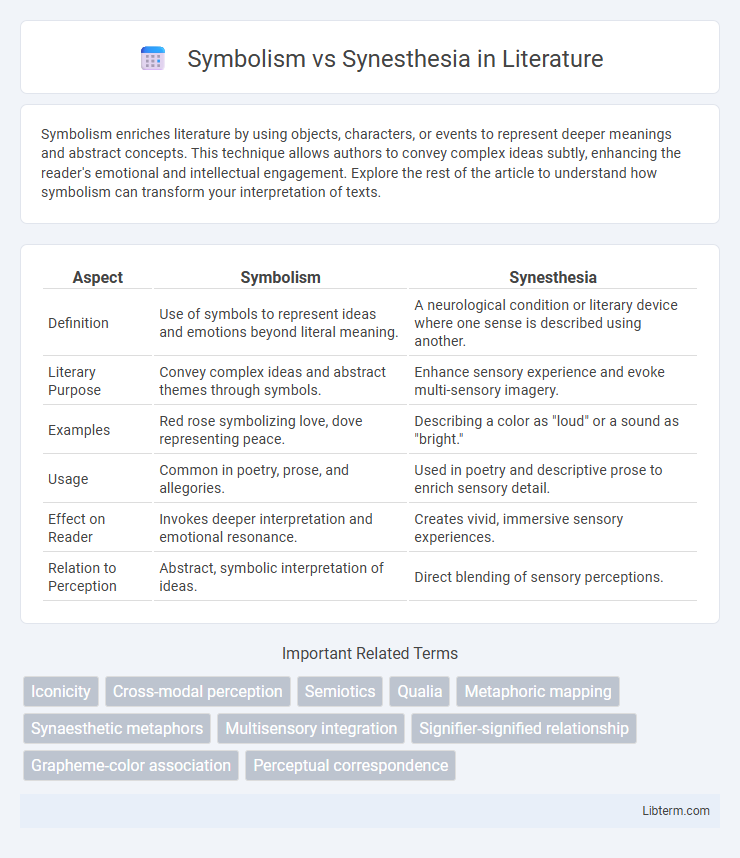Symbolism enriches literature by using objects, characters, or events to represent deeper meanings and abstract concepts. This technique allows authors to convey complex ideas subtly, enhancing the reader's emotional and intellectual engagement. Explore the rest of the article to understand how symbolism can transform your interpretation of texts.
Table of Comparison
| Aspect | Symbolism | Synesthesia |
|---|---|---|
| Definition | Use of symbols to represent ideas and emotions beyond literal meaning. | A neurological condition or literary device where one sense is described using another. |
| Literary Purpose | Convey complex ideas and abstract themes through symbols. | Enhance sensory experience and evoke multi-sensory imagery. |
| Examples | Red rose symbolizing love, dove representing peace. | Describing a color as "loud" or a sound as "bright." |
| Usage | Common in poetry, prose, and allegories. | Used in poetry and descriptive prose to enrich sensory detail. |
| Effect on Reader | Invokes deeper interpretation and emotional resonance. | Creates vivid, immersive sensory experiences. |
| Relation to Perception | Abstract, symbolic interpretation of ideas. | Direct blending of sensory perceptions. |
Understanding Symbolism: Definition and Key Features
Symbolism is a literary and artistic technique where symbols represent ideas or qualities beyond their literal meaning, often used to convey complex concepts through metaphorical imagery. Key features include the use of tangible objects, colors, or characters to evoke deeper emotional or intellectual resonance, allowing for multiple layers of interpretation. Understanding symbolism enhances the appreciation of nuanced narratives and the underlying messages embedded within creative works.
Exploring Synesthesia: Meaning and Manifestations
Synesthesia is a neurological phenomenon where stimulation of one sensory pathway leads to automatic, involuntary experiences in a second sensory pathway, such as seeing colors when hearing music. It manifests in various forms, including grapheme-color synesthesia, where letters or numbers are perceived as inherently colored, and chromesthesia, where sounds trigger specific visual hues. Understanding synesthesia offers insight into sensory integration and contrasts with symbolism, which uses culturally constructed signs to represent ideas rather than cross-sensory perception.
Historical Roots of Symbolism and Synesthesia
Symbolism originated in the late 19th century as an artistic and literary movement emphasizing the representation of ideas and emotions through symbolic imagery and motifs, with roots tracing back to Romanticism and mysticism. Synesthesia, a neurological phenomenon where stimulation of one sensory pathway leads to involuntary experiences in another sensory modality, has historical references dating to ancient Greece but was scientifically documented in the 19th century by figures like Francis Galton. The divergence in their origins highlights symbolism's philosophical and cultural evolution compared to synesthesia's basis in perceptual science and neuropsychology.
Symbolism in Art and Literature
Symbolism in art and literature utilizes objects, colors, and motifs to represent abstract ideas, emotions, or states of mind, enriching the narrative by conveying deeper meanings beyond the literal. Originating in the late 19th century, Symbolist artists like Gustave Moreau and writers such as Charles Baudelaire emphasized imagination, spirituality, and the mystical through symbolic imagery. This movement profoundly influenced modern literature and visual arts by encouraging subjective interpretation and evoking complex psychological and philosophical themes.
The Science Behind Synesthesia
Synesthesia is a neurological condition where stimulation of one sensory pathway leads to automatic, involuntary experiences in a second sensory pathway, such as seeing colors when hearing sounds. Scientific studies using functional MRI have shown that synesthetes exhibit increased cross-activation between brain regions responsible for different sensory modalities, particularly between the fusiform gyrus and the auditory cortex. This cross-wiring differs significantly from symbolism, which relies on learned associations and cultural meanings rather than innate neural connections.
Comparing Perceptual Experiences: Symbolism vs Synesthesia
Symbolism relies on culturally learned associations where symbols represent ideas or emotions through visual, linguistic, or contextual cues. Synesthesia involves a neurological condition where stimulation of one sensory modality automatically triggers a simultaneous, involuntary experience in another sensory modality, such as seeing colors when hearing music. The perceptual experience in symbolism is interpretive and abstract, while synesthesia provides a direct, multisensory perception that blends sensory inputs within the same individual's consciousness.
Cognitive Processes Involved in Symbolism and Synesthesia
Symbolism involves cognitive processes such as abstraction, pattern recognition, and associative thinking, enabling individuals to represent complex ideas through symbols. Synesthesia engages neural cross-activation, where sensory pathways overlap, resulting in automatic and involuntary blending of sensory experiences, like seeing colors when hearing sounds. Both processes rely on the brain's capacity for integrative perception but differ in mechanism: symbolism is learned and conceptual, while synesthesia is innate and perceptual.
Real-World Examples of Symbolism and Synesthetic Experiences
Symbolism often appears in literature and art, such as the use of a dove representing peace or a red rose symbolizing love, conveying deeper meanings through widely recognized icons. Synesthetic experiences occur when individuals perceive stimuli through multiple senses simultaneously, for example, seeing colors when hearing music or associating specific tastes with words, which are documented in neurological studies. Real-world examples include painter Wassily Kandinsky, who experienced color-hearing synesthesia, blending auditory and visual elements, and poets like William Blake, whose works use symbolic imagery to evoke profound emotional responses.
Impact on Creativity and Artistic Expression
Symbolism enhances creativity by allowing artists to embed deeper meanings and evoke complex emotions through metaphorical imagery and motifs. Synesthesia influences artistic expression by blending sensory experiences, enabling creators to produce multi-sensory works that connect colors, sounds, and textures in novel ways. Both phenomena expand the creative process, enriching art with layered interpretations and innovative sensory combinations.
Bridging the Gap: Interpreting Symbolism Through Synesthetic Lenses
Bridging the gap between symbolism and synesthesia involves interpreting symbols through sensory cross-activation, where abstract concepts evoke multisensory experiences, enhancing comprehension and emotional impact. Synesthetic perspectives allow symbolic representations to transcend traditional meanings by engaging multiple sensory modalities simultaneously, enriching narrative depth and cognitive resonance. This interdisciplinary approach facilitates deeper insight into cultural and psychological symbolism by linking visual, auditory, and tactile stimuli inherent in synesthetic perceptions.
Symbolism Infographic

 libterm.com
libterm.com